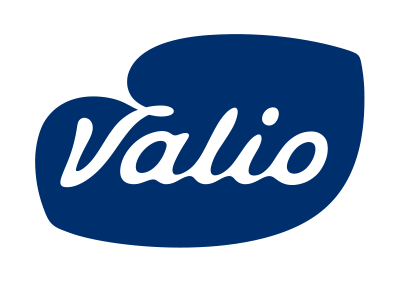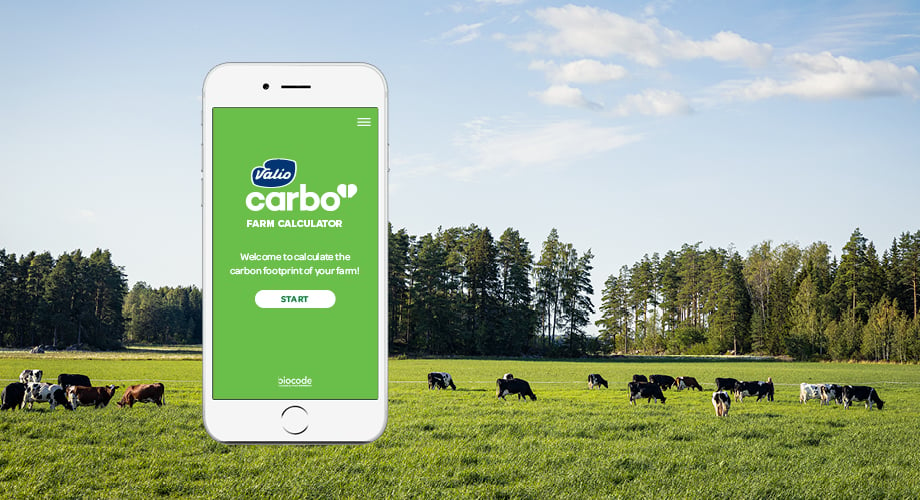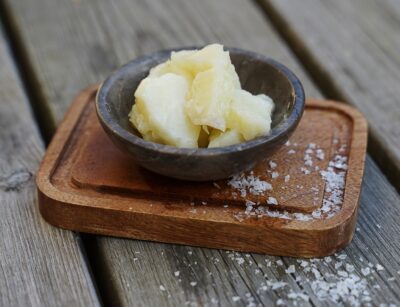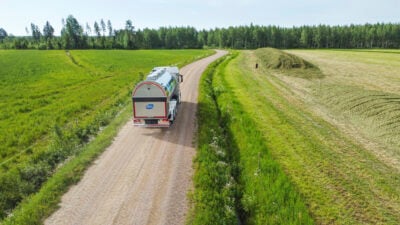Valio’s aim is to cut the carbon footprint of milk to net zero by 2035. To accelerate its journey, the company is now launching a calculator that its farms can use to measure their own carbon emissions and identify the most effective actions to lower them. These actions are likely to result in dairy products with a lower carbon footprint. The methodology behind the tool is certified by global climate and sustainability experts, the Carbon Trust.
Emissions from milk production can be reduced in many ways. One of the most important methods is carbon farming, i.e. farming methods that maximize the carbon sequestration capacity of fields. The carbon footprint also decreases by increasing the per-hectare harvest of grass for feeding cows. Cow welfare also has a big climate impact: emissions per litre of milk are reduced when cows live longer and produce milk well. The proper handling of manure also reduces emissions: tilling manure into soil rather than spraying it reduces nutrient runoff, and less industrial fertilizers are needed. Some dairy farms are already using their own biogas plants. The energy they produce from manure can be used to heat the farm and to power the milking equipment, for example.
Over the decades, Finnish dairy farms have done a lot of work to reduce their carbon footprint. The global average carbon footprint of raw milk is currently 2.5 kg CO2e per litre (Source: FAO). In Finland, we estimate the figure is around 1 kg CO2e per litre. Using the calculator, emissions reductions can be measured and verified at the farm level.
– Finnish cows’ methane emissions per litre of milk have halved in 50 years as a result of improved animal productivity, health, and nutrition. Cows today can produce more milk with the same amount of feed. Despite this development, our climate impact is still significant. We are humble about the challenges and we are pursuing ways to lower the figures even further. This is the first carbon footprint calculator in Finland developed specifically for dairy farms, says Aleksi Astaptsev, Valio’s scientist who developed the calculation model.
Actions reducing emissions are also savings actions
Farmers can play an important role in reducing carbon emissions because a big part of the footprint of food is generated in primary production. Valio is a company owned by 4,700 Finnish milk producers and it pays all its profits to the dairy farms.
Rami Rauhala and his wife Johanna operate a 65-cow dairy farm in Sievi, western Finland. The carbon footprint of the Hilliaho dairy farm was calculated as part of the work to develop the calculator.
– Climate-smart milk production is also resource efficient, i.e. it makes good sense economically. Most of the fields on our farm are either grass silage or grazing pastures. We have also over-seeded to make the vegetation as thick as possible. In our area, the significance of reparcelling is also big. Parcels that have over time become fragmented have been reparcelled into feasible parcels among land owners. When fields are closer to the farm centre, tractors use less fuel. It has been great to notice that us milk producers are part of the solution to climate change. I believe that a growing share of consumers value our work as environmentally sustainable food producers, says Rauhala.
Valio’s goal is that all its farms are using the tool within the next five years. So far, data has been collected from 100 farms.
– We have scheduled a training roadshow for dairy farms and we are providing them with online support, too. The calculator is easy to use and the farmers already have most of the data at hand. I estimate that the average farm can lower its emissions by 30 percent by 2025. At the same time, we are of course working to reduce emissions from Valio’s factories, transportation and in packaging,” Astaptsev continues.
Certified calculation model
Valio’s carbon footprint calculation uses the Intergovernmental Panel on Climate Change (IPCC) methodology and data from Valio’s own scientific work that started as animal nutrition research 10 years ago.
– It is great to see Valio create this carbon calculator in order to help their farmers drive down their carbon emissions. It demonstrates the company’s commitment to minimising its emissions and we are pleased to have certified its calculator, says John Newton, Associate Director, Carbon Trust.
Valio will continue developing the carbon footprint calculator. Life cycle models for calculating the carbon footprint of food products do not currently include the soil’s carbon balance. So the carbon footprint of milk, or of any other food, doesn’t include the emissions or carbon binding of the soil.
– Carbon binding in grass fields and emissions from farming peat fields should also be included in the calculations in order to get a more accurate picture of a food’s carbon footprint. Another area of development is combining the nutritional values of different foods with their carbon footprints,” Astaptsev concludes.
Background information
Carbon footprint
The carbon footprint is a single-figure or range representation of a product or activity’s greenhouse emissions. Greenhouse gasses, such as methane, nitrogen oxide, and carbon dioxide, released by the product or activity are converted to a common format, the carbon dioxide equivalent. The carbon footprint is always an estimate and it varies between different farms.
Milk’s carbon footprint
Cows convert the energy and nutrients in grass into milk. This is called rumination, and its price is the methane that is generated in the animal’s rumen. Most of milk production’s emissions (40-50%) are created in the cow’s rumen as well as in manure storage. The second largest share (35-45%) of the carbon footprint is generated in feed production, which releases nitrous oxide. The carbon dioxide generated in different stages of the production chain, e.g. in energy production for factors and in transportation, forms another notable part (10-15%) of the carbon footprint.
Guidelines for calculating a carbon footprint
The Intergovernmental Panel on Climate Change, IPCC, provides guidelines on calculating a food’s carbon footprint at three levels of accuracy. Valio uses the most accurate, i.e. level 3 guidelines, applicable to Finland. Most methods utilised to calculate the carbon footprint rely on general estimates found in external databanks.
Level 1: Emission factors are provided by IPCC
Level 2: Emission factors are calculated with IPCC-provided formulas and parameters
Level 3: Use of the most accurate national calculation methods, factors, and parameters
Emission reductions vs. compensations
It’s also possible to compensate for carbon footprints, i.e. to offset emissions through external actions, such as afforestation projects in developing countries. This does not reduce or change a product’s true carbon footprint. At Valio, our priority is to focus on minimising the emissions in our own production chain in order to permanently reduce emissions. In 2020, we will set targets that are in line with the Paris Agreement: the temperature increase must be limited to 1.5 degrees.




